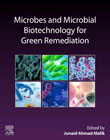
Microbes and Microbial Biotechnology for Green Remediation provides a comprehensive account of sustainable microbial treatment technologies. The research presented highlights the significantly important microbial species involved in remediation, the mechanisms of remediation by various microbes, and suggestions for future improvement of bioremediation technology. The introduction of contaminants, due to rapid urbanization and anthropogenic activities, into the environment causes unsteadiness and distress to the physicochemical systems, including living organisms. Hence, there is an immediate global demand for the diminution of such contaminants and xenobiotics which can otherwise adversely affect the living organisms. Over time, microbial remediation processes have been accelerated to produce better, eco-friendlier, and more biodegradable products for complete dissemination of these xenobiotic compounds. The advancements in microbiology and biotechnology lead to the launch of microbial biotechnology as a separate area of research and contributed dramatically to the development of the areas such as agriculture, environment, biopharmaceutics, and fermented foods. Microbes stand as an imperative, efficient, green, and economical alternative to conventional treatment technologies. The proposed book provides cost-effective and sustainable alternatives. This book serves as a reference for graduate and postgraduate students in environmental biotechnology and microbiology as well as researchers and scientists working in the laboratories and industries involved in research related to microbiology, environmental biotechnology, and allied research. Discusses important microbial activities, such as biofertilizer, biocontrol, biosorption, biochar, biofilm, biodegradation, bioremediation, bioclogging, and quorum sensing Covers all the advanced microbial bioremediation techniques which are finding their way from the laboratory to the field for revival of the degraded agro-ecosystems Examines the role of bacteria, fungi, microalgae, Bacillus sp., Prosopis juliflora, Deinococcus radiodurans, Pseudomonas, methanotrophs, siderophores, and PGPRs as the biocontrol and green remediator agents for soil sustainability INDICE: Part I. Microbial Bioremediation: An Introduction1. Microbial Biotechnology: An Introduction2. Bioremediation of Soil: An Overview3. Microbial Interaction With Metals And Metalloids4. Emerging Issues and Challenges for Microbe Assisted RemediationPart II. Microbes for Sustainable Agriculture and Green Remediation5. Microbe-Mediated Biotic and Abiotic Stress Tolerance in Crop Plants6. Promoting Crop Growth with Symbiotic Microbes in Agro-Ecosystems - I7. Promoting Crop Growth with Symbiotic Microbes in Agro-Ecosystems - II8. Plant Growth Promoting Rhizobacteria: An Alternative for NPK Fertilizers9. Biochar and its Potential Use for Bioremediation of Contaminated Soils10. Bioremediation with Biochar and its Microbial Aspects11. Role of Biofilms in Bioremediation12. Microalgal Adsorption of Carbon Dioxide (CO2): A Green Approach13. Photosynthesis in Bioremediation14. Lipase and Lactic Acid Bacteria for Biodegradation and Bioremediation15. Unique Extremophillic Bacillus: Their Application in Plant Growth Promotion and Sustainable Agriculture16. The Role of White Rot Fungi in Bioremediation17. Biodiversity and Application of Native AM Fungal Species with Rhizobacteria on Growth and Yield Enhancements in Cowpea and Aromatic Black Rice from North Eastern India18. Bacterial Retting Agents: Sustainable Bioremediation of Bast Fiber Farming Strains19. Streptomyces Sp. - A Feasible Bio-Control Agent for Sustainable Management of Crop DiseasesPart III. Emerging Contaminants and their Remediation20. Microbial-Assisted Remediation of Food Processing Industry Waste21. Role of Biosorption Technology in Removing Cadmium from Water and Soil22. Role of Biosurfactants on Microbial Degradation of Oil-Contaminated Soils23. Bio-Clogging and Microbial Enhanced Oil Recovery (MEOR)24. Microbial Degradation of Phenolic Compounds25. Microbial Biofilm-Mediated Bioremediation of Heavy Metals: A Sustainable Approach26. Arsenic Accumulating and Transforming Bacteria: Isolation, Potential Use, Effects, and Transformation in Agricultural Soil27. Microbial Remediation of Hexavalent Chromium from the Contaminated Soils28. Microbial Bioremediation of Polythene and Plastics - A Green Sustainable Approach29. Biodegradation of Microplastics and Synthetic Polymers in Agricultural Soils30. Microalgae - A Promising Tool for Plastic Degradation31. Emerging Issues and Challenges for Plastic Bioremediation32. Usage of Microbes for the Degradation of Paint Contaminated Soil and Water33. Microbial Degradation of Pharmaceuticals and Personal Care Products34. Microbial Remediation of Mercury-Contaminated Soils35. Mercury Pollution and Bioremediation by Microbes36. Role of Bacterial Nanocellulose Polymer Composites on the Adsorption of Organic Dyes from Waste Water37. Environmental Risk Assessment of Fluoride (F) Contaminated Soil on Prosopis Juliflora Seedlings using Biochemical and Molecular Parameters38. Arsenic Toxicity and its Clinical Manifestations in Murshidabad District with Some Potential Remedial Measures39. Application of Deinococcus radiodurans for Bioremediation of Radioactive Wastes40. Microbial Bioremediation and Biodegradation of Radioactive Waste Contaminated SitesPart IV. Recent Trends and Tools41. New Insights of Cellulosic Ethanol Production from Lignocellulosic Feedstocks42. Mycorrhizal Product Glomalin: A Proficient Agent of Nutrient Sequestration And Soil Fertility Restoration under Jeopardized Agroecosystem43. Microbial Quorum Sensing Systems: New and Emerging Trends of Biotechnology in Bioremediation44. Metagenomics - A Genomic Tool For Monitoring Microbial Communities During Bioremediation45. Nanobioremediation: A Novel Application of Green-Nanotechnology in Environmental Clean-Up46. Nanotechnology and Green Nano-Synthesis for Nano-Bioremediation
- ISBN: 978-0-323-90452-0
- Editorial: Elsevier
- Encuadernacion: Rústica
- Páginas: 600
- Fecha Publicación: 01/08/2022
- Nº Volúmenes: 1
- Idioma: Inglés
